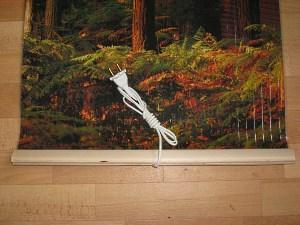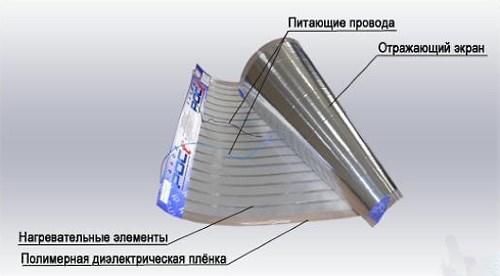Film heater for home and garden
 Film infrared heaters are devices designed for local or general heating of a dwelling and consisting of heating elements, film and foil that emit infrared radiation.
Film infrared heaters are devices designed for local or general heating of a dwelling and consisting of heating elements, film and foil that emit infrared radiation.
Heating is done by emitting infrared radiation, which is beneficial to humans. Such a device can be used at an initial air temperature of at least -40 degrees, that is, it works practically without temperature restrictions.

Read also the article in the topic: quartz heaters for summer cottages!
Video: wall-mounted film heater in the form of a picture
Film heater device
The film heater has a simple device that resembles a double sandwich. The metal foil, which is a resistive layer, is packed on both sides with Mylar heat-resistant film. One more layer of aluminum foil with a film is laid on top of the film. Heating elements are inserted inside such a sandwich. On such heaters, temperature sensors are used, which, when the required heating limit is reached, turn off the system, and when it falls to the set minimum temperature, they turn on again. This sensor allows significant energy savings.

To such a heating system, you can also add local thermostats, with which you can program the temperature for a day. Then, for example, in your absence, the infrared film wall heater will not work, but before arriving it turns on and starts heating.
Of course, such programmable thermostats cost more than conventional thermostats, but they also significantly increase the level of comfort. The thickness of this entire structure is no more than 0.5 mm.
The principle of operation of the film heater
Everything ingenious is simple, this phrase can be successfully applied to infrared film heaters, the principle of which is quite simple. Electric current from heating elements spreads through the resistive layer, heating it to a certain temperature.

This heat is transferred to the aluminum foil, which produces radiation. By emitting infrared radiation, the heater transfers heat energy to all objects in the room. And objects give off heat already into the room.
This principle of secondary heat propagation is very similar to natural heating by the sun.
The heat is very evenly distributed throughout the room and working according to this scheme, infrared film heaters have a very high efficiency. In general, infrared radiation is very beneficial for humans, helping to fight, for example, with colds and stomach diseases.
Installation of a film heater
To install a wall, floor or ceiling film heater, you do not need to use any special skills, but the basic rules must be taken into account:
- Place the heater on a dry, level surface.
- Cutting is done only along the lines indicated by the manufacturer.
- Do not connect the power supply to the rolled heater.
- The maximum length of the film should be no more than 8 m, and the distance between the panels should not be less than 5 mm.
- The foil heater must not be bent more than 90 degrees.
- Fastening to the wall is carried out with a construction stapler or special fasteners. It is forbidden to use screws or nails as fasteners.
- It is advisable not to carry out the installation at sub-zero temperatures and high humidity.

Installation of a film heater takes place in the following order. First, install the reflective foil screen on the prepared surface. The strips are installed with an overlap of up to 3 cm and are sealed with a special foil tape.
Then we place the heating elements in the foil and connect the power supply. It is desirable to hide the wires. After that, we mount the thermostat and test the system. Before installation, you need to carefully read the instructions, because each manufacturer may have their own nuances during installation, and it is very important to take them into account.

Views
There are three types of film heaters:
- outdoor;
- wall-mounted;
- ceiling.
A wall-mounted foil heater is considered the most ineffective due to the peculiarities of heat transfer. After all, warm air rises and this significantly limits the heating area.
Therefore, as the main type of room heating, they are not suitable, but as an additional one, they are used everywhere.
Ceiling film infrared heaters are more efficient. Infrared radiation is directed downward and heats objects, from which heat is evenly distributed throughout the room. They can be mounted on almost any type of ceiling covering and their installation does not cause any additional inconvenience, as it might seem at first. In addition, the undoubted advantage of such a heater is the absence of the risk of accidental damage.

If you are wondering how to choose a film heater for a summer residence, then for this purpose, the ceiling option is the most suitable.
- Firstly, the absence of apartments on top excludes the possibility of flooding and damage to such equipment.
- Secondly, a large heating area does not require the use of additional heating systems.
The obvious disadvantages of such coatings include the heating of household appliances and the inability to use, with a ceiling height of more than 3.5 m. In this case, the cost of heating increases dramatically and it becomes less effective.
The floor covering can be installed under any final covering. The main advantage is the lack of impact on household appliances. The disadvantage is the undesirability of being under heavy furniture, due to the possibility of damage.

The main advantages and disadvantages of infrared film heaters
The advantages are as follows:
- Positive health benefits. It is especially noticeable in winter, in the absence of the sun, when infrared radiation compensates for the lack of natural light and makes up for all the losses of the body associated with this problem.
- Easy installation. For example, a wall panel film heater is mounted quite simply and quickly. Moreover, this can be done independently, without the participation of specialists, but after carefully reading the instructions. The same can be said for ceiling and floor units.
- Long service life. Is from 25 years and more. Maintenance-free due to design features and simplicity of the device.
- Low financial costs. The equipment itself has a low cost, in addition, installation and subsequent operation may not bear any financial burden.
- Fire safety. Typically, the surface of the heater has a temperature of no more than 80 degrees, which is a safe limit.
- No noise and high environmental friendliness.The operation of such a heater does not cause noise, in addition, in the process of using infrared film, there is no drying and burnout of oxygen.
The main disadvantages of film heaters:
- Cooling down quickly after shutdown. If you read reviews about film heaters, then this is one of the main disadvantages voiced by consumers.
- Poor heating. Some buyers note the low quality of heating. Although this may refer to a small area of film hanging on the wall. If you completely cover the ceiling or floor, then this problem is not observed.
- Heating household appliances. This disadvantage is typical for a ceiling film infrared heater.
- Impossibility of surface treatment. When using such heaters, there are some restrictions in the design of the room as you wish.